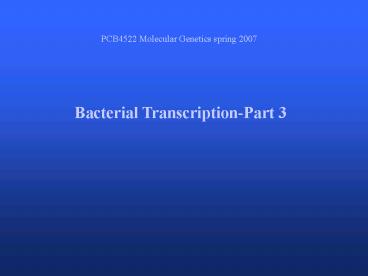Building the preinitiation complex - PowerPoint PPT Presentation
1 / 17
Title:
Building the preinitiation complex
Description:
Lac repressor inhibits transcription by DNA looping ... The lambda repressor binding overlaps a weak -35 region of the PR promoter. The repressor binds to the ... – PowerPoint PPT presentation
Number of Views:87
Avg rating:3.0/5.0
Title: Building the preinitiation complex
1
PCB4522 Molecular Genetics spring 2007
Bacterial Transcription-Part 3
2
Oligomeric transcription factors are often held
together through a-helical regions known as
Leucine Zippers.
Leucine Zipper (coiled-coil)
Protein-protein interactions
Hydrophobic heptad repeat
3
Leucine Zipper (coiled-coil)
Protein-protein interactions
Hydrophobic heptad repeat
abcdefg
leu
leu val ile ala
a and d positions form a hydrophobic face of
the a-helix.
4
Leucine Zipper (coiled-coil)
Used in protein-protein interactions 4-3
repeats of hydrophobic residues
Helical wheel diagram of the bZIP domain of the
GCN4 heptad repeat
L
V
abcdefg
L
V
L
N
There are 3.6 amino acid residues per turn in an
a-helix of protein.
g
L
g
V
e
L
M
c
c
b
d
d
a
f
f
f
a
d
a
L
M
b
b
L
e
V
c
e
g
NOTE hydrophobic residues are present at the a
and d positions.
L
Two leucine zippers interacting
N
L
V
L
V
5
Lac repressor inhibits transcription by DNA
looping
Weaver, R., (1999) Molecular Biology, McGraw-Hill
6
lambda repressor
Helix-turn-helix recognition helix reads the DNA
without melting
Mark Ptashne
Lambda repressor, mechanism of activated transcrip
tion in eukaryotes
The idea of repressors was first proposed by
Jacob Monod, 1961
Fig. 11.17, 11.18 11.20
7
Lambda repressor binds the major groove with a
H-T-H
Weaver, R., (1999) Molecular Biology, McGraw-Hill
8
Lambda repressor both activates and represses
Figure
Weaver, R., (1999) Molecular Biology, McGraw-Hill
9
Lambda repressor activates by contacting sigma 70.
The lambda repressor binding overlaps a weak -35
region of the PR promoter. The repressor binds to
the opposite face of the DNA and makes contact
with domain 4 of sigma stabilizing its
interaction with the promoter.
Figure
-35
-10
sigma
Weaver, R., (1999) Molecular Biology, McGraw-Hill
Lambda repressor
10
Operon A complete regulatory system which
includes the structual genes encoding either
proteins or RNAs, the promoters and cis-elements,
and genes encoding specific regulatory proteins
(activators and repressors).
Cis-elements are DNA sequences that regulate
transcription often by binding RNA polymerase or
regulatory proteins. An Operator is site for
repressor binding.
Trans-acting factors are proteins that regulate
transcription often by binding to cis-elements.
11
Arabinose BAD operon
AraC repressor
- arabinose
AraC
arabinose
- Catabolite-repression operon (like lac).
- CAP site is 200 bp upstream positive regulator
- AraC binds arabinose and changes configuration
- to then bind araCI1and I2 sites.
Weaver, R., (1999) Molecular Biology, McGraw-Hill
12
ara operon
araC
araC
DNA looping operators must be on the same
helical face.
NOTE if you add or remove 5 bp, you change the
helical face for the operator binding and loose
the ability to form the loop structure.
Weaver, R., (1999) Molecular Biology, McGraw-Hill
13
Autoregulation of the ara operon
araC
NOTE here, araC is acting like a classical
repressor in blocking RNA polymerase binding.
Weaver, R., (1999) Molecular Biology, McGraw-Hill
14
Nitrogen starvation gene glnA (glutamine synthase)
Anabaena (cynobacterium) The E. coli promoter is
also dual.
Dual promoters the vegetative promoter is read
by sigma 70 and is weak. The nif-like promoter is
much stronger and is read by sigma 54. This
allows the gene to be active under normal
conditions and when NH4 is in short supply.
Example of a scheme to have two kinds of
regulation control the same operon have two
promoters, each with its own sigma.
Weaver, R., (1999) Molecular Biology, McGraw-Hill
15
glnA promoter
The s54 is defective. It is unable to melt the
promoter without added ATP and the NtrC protein.
NtrC helps sigma 54 melt the promoter. ATP is
hydrolyzed by the ATPase domain of NtrC and
provides the energy for melting. The NtrC binding
site (enhancer) must be at least 70 bp away from
the promoter to function leaving room for a DNA
loop. In addition, NtrC can also function on a
different DNA molecule if the two DNAs are
concatenated (see fig.). This allows the two
proteins to interact, but precludes an alteration
of supercoiling or sliding as mechnisms.
Weaver, R., (1999) Molecular Biology, McGraw-Hill
16
Electron microscopy of DNA looping at the glnA
promoter
RNA pol
NtrC
DNA looping implicated the operators must be at
least 70 bp apart.
Weaver, R., (1999) Molecular Biology, McGraw-Hill
17
glnA promoter
Core sigma 54 NtrC heparin
Sigma 54 can cause the holoenzyme to bind to the
promoter, but is unable to form the open promoter
complex.
heparin
(left) Open promoter complexes are
Heparin-resistant. Lane 3 ATP lanes 1 4
no proteins.
Gel mobility shift assay
(right) DMS treated complexes show
single-stranded DNA at the promoter when ATP is
present.
DNase footprinting
Weaver, R., (1999) Molecular Biology, McGraw-Hill































